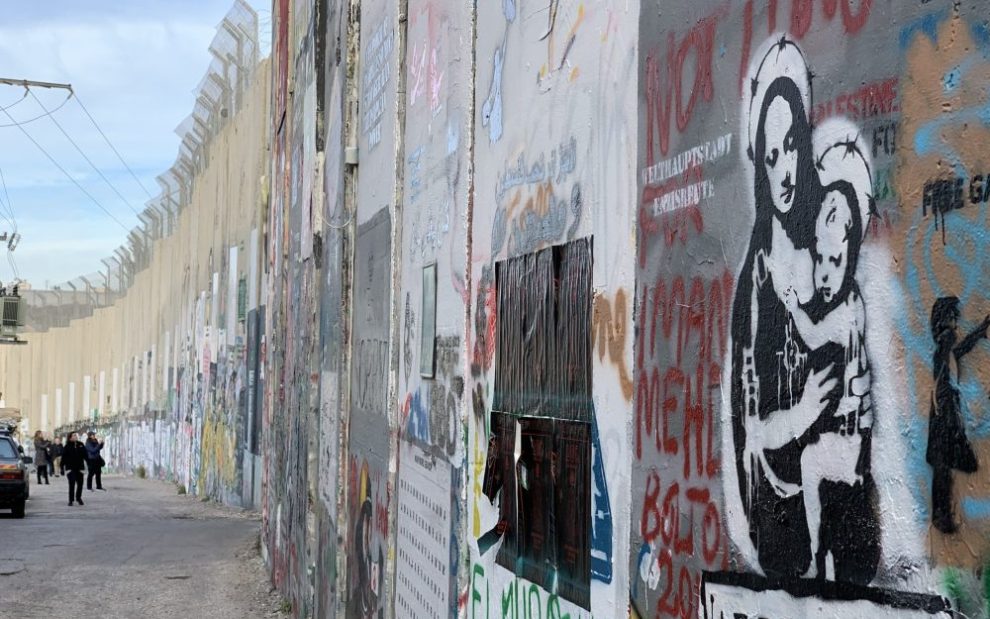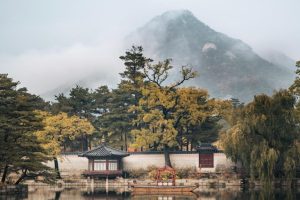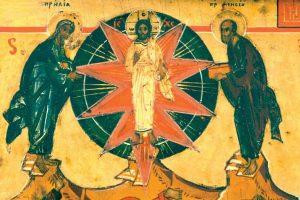This essay is also available to listen to as an audio recording.
Shortly before the outbreak of the COVID-19 pandemic, I traveled to Israel-Palestine as part of an interreligious pilgrimage for Georgetown University faculty and staff. We visited religious sites that are holy to Jews, Muslims, and Christians and bore witness to the political and everyday realities there. Each morning began with a prayer led by one of our campus chaplains—a priest, rabbi, and imam—and each evening ended with group reflection.
In Jaffa, we explored old mosques decorated with colorful stained glass and intricately painted domes. On Mount Gerizim, we met with the tiny Samaritan community, who greeted us with sweets. In the lush green hills of Galilee, we said Mass on the seashore and visited centuries-old synagogues in a town famous for Jewish mysticism. Along the way, we ate meals with local Israeli and Palestinian families and met with numerous clergy, educators, activists, government officials, and ordinary people who shared their expertise and stories. This included two men brought together by loss: a Jewish Israeli father whose adult child was killed by a Palestinian suicide bomber while serving in the military and a Muslim Palestinian father whose daughter was killed by an Israeli soldier.
After several days spent crisscrossing Israel and the West Bank, we finally arrived in Jerusalem. As our bus circled a forest of pine trees, the rabbi led us in a traditional Jewish song for the city. While there, we visited the Western Wall, the holiest prayer site for Jews; admired the Dome of the Rock, where Muslims believe that the Prophet Muhammad ascended to heaven to encounter God; and walked along the narrow Via Dolorosa, the Way of Sorrows, praying the stations of the cross and remembering the final, tormented moments of Jesus’s life.
As we approached the fourth station, we stepped through a stone archway and into a dimly lit room where we found a simple statue of Jesus carrying his cross and looking into the eyes of his mother, Mary. The two Jesuits with us recited the prayers aloud and asked us to contemplate Mary’s grief over the suffering of her son. In the dark and quiet, many of us—Jewish and Muslim, Catholic and Protestant—started to weep. Some of us had heard this story countless times before; for others, it was their first time. Yet, as our sniffles and cries echoed in the room, we forged a deep bond. Together, we were mourning not only this mother and son of two millennia ago, but all the suffering parents and children of today, in the Holy Land and beyond.
Today’s Marys and Jesuses are too many. They are the Gazan mothers who kiss the limp bodies of their children, killed by Israel’s bombing. They are the Israeli parents huddled with their children under the sound of rocket fire, and whose children were taken from them by Hamas during the attack on October 7. They are the Palestinian preemies who were left to die when the Israeli military incursion forced hospitals to evacuate and cut off power to lifesaving incubators. And they are the West Bank fathers and children who have been shot and killed by Israeli soldiers and settlers.
Seeing these images on my social media feed in recent weeks, my mind has gone back to that moment of shared grief along the Via Dolorosa. Many other memories of the Holy Land have resurfaced, too. On that pilgrimage, and during three prior visits I made to Israel-Palestine, I witnessed grave and long-standing injustices, ones that are often hidden from view.
As our tour bus wound through the West Bank, passing olive groves atop stony hills, we drove on roads that most Palestinian residents are often barred from using, and that are instead reserved for Israeli settlers and tourists. The West Bank is a territory which is nominally Palestinian, but it is largely controlled by the Israeli military, with small pockets of Palestinian civil or military control. Often likened to a piece of Swiss cheese, the territory has been fragmented by these segregated roads, Israeli military-manned checkpoints, a massive separation wall that cuts through communities, and settlement towns that were built for Jews only (and are often funded by Christian groups in the United States). West Bank Palestinians often find their homes, farmland, and olive groves confiscated or destroyed by Israeli forces and settlers. In recent years, and even more so since October 7, violence by Israeli settlers against Palestinians has increased, displacing entire Palestinian communities and receiving tacit support from the government. Living under Israeli military occupation means that West Bank Palestinians lack many basic political rights; they have little to no say over the regime that governs them.
In the West Bank village of Kifl Haris, we visited the childhood home of our campus imam. Showing us around the living room, he pulled a Bible off a bookshelf. Holding a flashlight over the pages, he read verses of the New Testament in Arabic. “My first experience of interfaith dialogue,” he told us, smiling, “was reading this Bible as a boy.” Afterward, when we toured the town, local young people and children joined us. A few months later, we learned that one of those young men, Ibrahim Abu Yaaqoub, had been shot and killed by an Israeli soldier while walking with his friend one night. And later that year, two of the imam’s nephews were arrested and imprisoned indefinitely, without charge, and without access to lawyers—a common Israeli policy known as “administrative detention.” The frequent killing and imprisonment of Palestinians, including children, by Israeli forces is a fact of life in the West Bank. These problems were already accelerating in 2023 before October 7, but they exploded dramatically in the weeks following, while international attention was focused on Gaza.
We also visited Hebron, the largest city in the West Bank and the only Palestinian city with an Israeli settlement in the middle of it. Our first stop was to the tomb of Abraham and his family members. Manned by the Israeli military, half of the complex is now a synagogue and half is a mosque; most days of the year, Muslims are prohibited from some areas and Jews from others, with the goal of limiting violence that plagued the site in decades past. The Christians in our group, however, could tour both sides. The building, dating from the time of King Herod, is a large, ancient stone complex, full of rooms decorated in calligraphy, colorful carpets, and intricate latticework. As I turned the corner to the place where Abraham is buried, I found my eyes welling up. Sitting there as Jewish pilgrims recited prayers in Hebrew, I was overcome by the feeling that we—Abraham’s descendants: Christian, Jewish, and Muslim—have let him down by allowing ourselves to be torn apart.
After exploring the mosque side of the building, we walked down Shuhada Street, once a main thoroughfare in Hebron and the center of Palestinian life. Now, Israel bars Palestinians from that street and many others. Former businesses have been shuttered for years and the road was completely deserted, except for a group of young Israeli boys from the settler community who ran through, seeming to train for a cross country race. We were led around the city by a former Israeli soldier who works with a group of veterans called Breaking the Silence, which seeks to inform the public about the realities in the occupied Palestinian territories. We finished the day hearing from a rabbi working for reconciliation, and then climbed a hill overlooking the city. There we were served a piping hot meal of maqloubeh—Arabic for “upside down”—prepared for us by Palestinian activists.
We also spent time in Bethlehem, the place of Jesus’ birth. A predominantly Muslim town, the city displayed a large Christmas tree in the central square, and a man dressed as Santa Claus greeted us after we visited the ancient Church of the Nativity. We walked along the towering separation barrier, an ever-expanding wall built by Israel in the wake of suicide bombings against Israeli civilians and military by Palestinian militant groups like Hamas. While suicide attacks did decline somewhat after the wall’s partial construction, it has also allowed Israel to annex large swathes of Palestinian areas, impede Palestinian movement, and expand Jewish settlements. The wall does not run between Israel and the West Bank, but rather snakes through the latter, including through parts of Bethlehem that used to be bustling and vibrant. Walking along the wall, we saw portions painted with large murals and plastered with poetry. One particularly poignant image depicted Mary holding her infant son, their heads encircled with barbed wire halos and the scope of a gun centered on her chest.
On a previous visit to the Bethlehem in 2014, I explored protest art in another area of the city with my parents and now-husband, guided by a local cab driver, Muhammad. Gradually, we began to notice a prickling sensation around our nostrils and eyes. “Come back to the car,” Muhammad said with urgency, “Yullah!” We quickly learned that, a few streets over, Israeli forces had begun firing tear gas to disperse demonstrators. They were protesting the recent murder of a Palestinian man by Israeli soldiers at the border with Jordan. We shuddered when we realized that just a day before, we had passed through that same border crossing.
During these pilgrimages, I also prayed in numerous historic churches, at least two of which had been (or later would be) attacked by Israeli Jewish vandals. Arson, anti-Christian graffiti, desecration of churches and Christian cemeteries, and attacks on clergy have risen sharply in recent years in Israel. In early 2023, the Christian leaders of the Holy Land tried to alert the world of the rising anti-Christian persecution and violence. Palestinian Christians face more systemic issues, too. Those in the West Bank and Gaza are also often barred from visiting Christian religious sites in other parts of country, and they face the many of the same realities as their Muslim counterparts, including land dispossession, restrictions on movement, and the profound economic hardship that comes along with political inequality. It is thus no surprise that many Palestinian Christians have left their homeland, joining others who previously left for better economic prospects or were displaced as refugees in the wake of Israel’s creation.
The modern state of Israel was founded in 1948 on the notion that the Jewish people needed their own homeland to be safe. This movement, known as Zionism, emerged in the late 1800s long before the Holocaust—when Nazi Germany and its allies killed six million Jews and many others in the 1930s and 1940s—but it would gain momentum during the world wars as antisemitism in Europe worsened. Jews already lived, as a minority population, in the land that was then known as Palestine, ruled by the Ottoman Empire, and Jewish immigration there began to increase. The British took over the region after World War I; a couple years prior, they had promised the Jewish people a homeland through the “Balfour Declaration.” Though a United Nations plan to partition the land between both Jews and Palestinians was proposed, it was not implemented, in part because the division granted the Jewish state more territory, even though the Palestinian Arab population constituted the majority. The British withdrew amid increasing instability and violence. Israel declared itself a state in 1948 and the Arab-Israeli war ensued between the Zionist forces and surrounding Arab powers. While Israelis mark this as their war of independence, Palestinians refer to this as the Nakba or catastrophe, which resulted in around 750,000 Palestinians being expelled from their homes. Some were forced into what is now the West Bank and Gaza, while others became refugees in other countries. While some Palestinians who remained in Israel became citizens there, many Palestinians remain stateless and lack freedom and equality.
All of these realities form the backdrop of the tragic escalation in violence that the world has witnessed in Israel-Palestine in recent weeks. And I have not even mentioned the situation in Gaza, which was in dire straits before the latest onslaught; the densely-populated strip of land was under Israeli and Egyptian blockade, meaning that entry and exit of people and essential goods was extremely limited. While it is right for American Catholics to focus our immediate attention on pushing for an end to the violence in Gaza and return of hostages to Israel, we must still attend to the deeper issues that plague the Holy Land, if we ever hope to see a lasting, just peace there.
The human rights organizations Human Rights Watch, Amnesty International, and B’Tselem all characterize the conditions across Gaza, the West Bank, and Israel proper as de facto “apartheid.” This is because life in the territory that Israel controls—from the Jordan River to the Mediterranean Sea—is fundamentally unequal. Albeit in different ways in different areas, the Israeli state denies Palestinians many basic rights and is “advancing and cementing the supremacy of one group” over another. This can be observed on the ground, and it was made explicit in Israel’s 2018 Nation State Law, which, as the Catholic bishops of the Holy Land put it, “provide[s] a constitutional and legal basis for discrimination among Israel’s citizens,” privileging Jewish citizens above others. Catholic and other Christian leaders in the Holy Land have spoken out against this fundamentally unequal state of affairs, but have often gone unheard. Israel’s subjugation of Palestinians, which B’Tselem has described as “a routine founded on violence”— has beget more and more violence that has claimed the lives of thousands upon thousands of Israelis and Palestinians over the past 75 years. In this present moment, both Israelis and Palestinians feel the continuation of their respective historical traumas. It is estimated that, on October 7, more Jews were killed than on any other day since the Holocaust, and that the numbers of Palestinians killed (at least 15,000) and displaced (at least 750,000) in Gaza since then have already surpassed that of the Nakba in 1948.
In the face of the current atrocities and long-term injustices, it is easy to feel hopeless. And when I think of the suffering Marys and Jesuses of today, it is easy to do nothing but despair. But I have been trying to remember the stories of interfaith solidarity—how Jews, Muslims, and Christians are working together both in the Holy Land and around the world—to secure a more just and peaceful future. I’m also calling to mind the prayerful wisdom of our campus rabbi and imam, which they shared on our pilgrimage.
On our first night in the Holy Land, the rabbi led us in a ritual lighting of the candles for Hanukkah. The menorah we used was forged from old bullet casings, a tangible reminder of how harm can be transformed, even if not forgotten. She explained to us the story that inspires the ritual—how the ancient rabbis needed enough oil to light the temple for eight nights, but only had enough for one. Fully aware of their deficit, they lit the single candle anyway. Then, by some miracle, that one-day supply lasted all eight nights.
Toward the end of our trip, the imam recounted the Quran’s story of Jesus’ birth. In it, Mary is not laboring in a Bethlehem stable with Joseph, but out in the wilderness alone. Under a date palm tree, she cries out in pain, wishing she had never been born. Then a voice tells her to shake the trunk of the tree to bring down its fruits and to drink from a spring that has just appeared beneath her. God provides for her and comforts her. And the virgin delivers her son, a miracle.
These stories, from my Jewish and Muslim teachers, are ones for the contemporary moment. They do not encourage a naïve optimism, nor do they allow us to give up. Instead, they compel us to choose radical hope; they dare us to ask God to help us through that which seems impossible. They urge us on: Even in the unending darkness, light the candle. Even if God seems absent, shake the tree. There may be miracles yet to come.
Image: Courtesy of Jordan Denari Duffner













Add comment